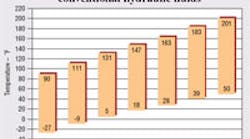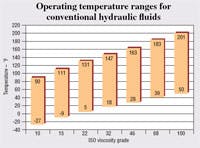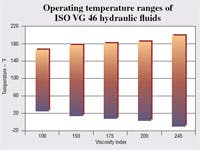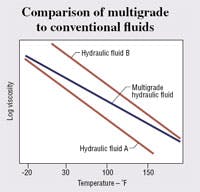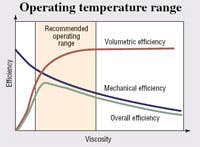Wouldn’t it be great if there was a single list you could consult to help you pick the right hydraulic fluid for your equipment? The closest thing is the National Fluid Power Association’s recommended practice T2.13.13-2002, Fluids - Viscosity Selection Criteria for Hydraulic Motors and Pumps*. It offers guidance but not definitive answers.
Unfortunately, fluid selection is not as simple as we’d like. Every application is different, and you need to pay attention to equipment manufacturers’ requirements, specifications, and recommendations as well.
But there are a few steps you can follow to help make your choice. First, determine the type of equipment where you will use the fluid. Second, consider the severity of the duty cycle. And third, determine what temperatures the equipment will experience during use.
Viscosity, antiwear levels are key in industrial use
Industrial hydraulic systems in normal service indoors generally use a conventional antiwear- type hydraulic fluid with appropriate viscosity. Choosing the right viscosity fluid is important because it ensures the system’s best overall performance and that the components are protected. The antiwear agents contained in the oil protect the hydraulic pump components from premature wear.
Figure 1 summarizes ISO 32, 46, and 6 8 , the most commonly used viscosity grades because they have the appropriate viscosity at the temperatures usually seen in industrial hydraulic systems. The temperature operating range is based on the lowest seand highest temperatures at which the viscosity remains between 860 cSt and 13 cSt, the range recommended by many equipment manufacturers for full load operation. Figure 2 provides more detail on ISO VG 46 fluids.
Different fluids for changing needs
The challenge is different with mobile equipment — used for offroad construction, timber harvesting, municipal wast e and utilities, for example. Mobile equipment can see high pressures, severe duty cycles, and wide temperature extremes during year-round use in areas with seasonal climates. Their fluid needs to work well at low temperatures for winter time start up, while maintaining enough viscosity at high temperatures to protect during severe service or hot weather.
The ideal hydraulic fluid for mobile applications is one that flows like a lighter oil at low temperatures but protects like a heavier oil at high temperatures: a multigrade hydraulic oil. This is similar to using SAE 5W-30 or 10W-30 multigrade engine oil in our cars, which can be used year-round without problems. In Figure 3, note that the multigrade fluid has the low-temperature fluidity of the lighter Fluid A, while maintaining the hightemperature viscosity of the heavier Fluid B.
Multigrade and conventional fluids
What differentiates multigrade hydraulic fluids from conventional fluids is that they contain polymer additives, called viscosity modifiers (VM) — also known as viscosity index improvers — in addition to the hydraulic performance package. These VMs keep the fluid viscosity more consistent over the temperature range encountered during use.
Multigrade fluids are also known as high viscosity index (VI) fluids. VI is a measure of how much a fluid’s viscosity changes with temperature. A higher VI number means the viscosity changes less as the fluid heats and cools, which is desirable. Conventional fluids typically have VI around 100. By comparison, a multigrade fluid should have VI of at least 140. There are fluids with VI higher than 200 for use in such temperature extremes as the Arctic or where viscosity must remain steady across a wide temperature range. See Figure 3.
Perks of multigrade fluids
Five of the benefits of using a good-quality, high VI-multigrade fluid are that it:
- Maintains a more consistent viscosity as temperature changes, so the system continues to perform properly.
- Flows better at low temperatures for improved cold-weather operation. The equipment wi l l experience fewer problems with cavitation, sluggishness, drift, or shudder.
- Maintains viscosity at high temperatures to protect system components and maintain overall efficiency.
- Provides greater mechanical and volumetric effectiveness, which improves energy efficiency and reduces fuel consumption.
- Can be used year-round and over wide temperature ranges.
Operating within the recommended viscosity range helps ensure that equipment is protected and that it operates most efficiently, as shown in the graph in Figure 4.
When choosing a hydraulic fluid, remember to ask your supplier if it is approved by your equipment manufacturer and for performance information. Make sure that the fluid that will be delivered to you is clean and water-free so it will perform at its best. Finally, be sure to conduct used oil analysis as recommended by your supplier to understand when your oil may need attention.
For more information, contact [email protected].
*National Fluid Power Association recommended practice T2.13.13-2002 Fluids — Viscosity Selection Criteria for Hydraulic Motors and Pumps, may be purchased at www.nfpa.com
